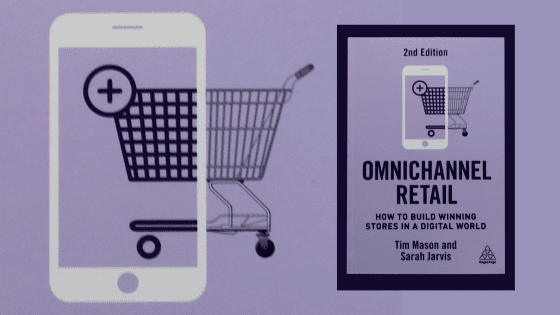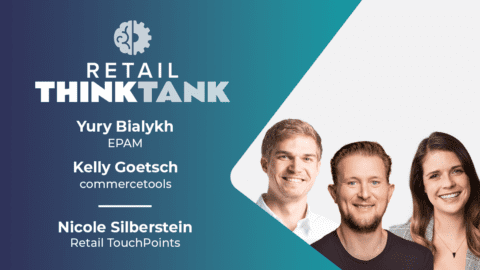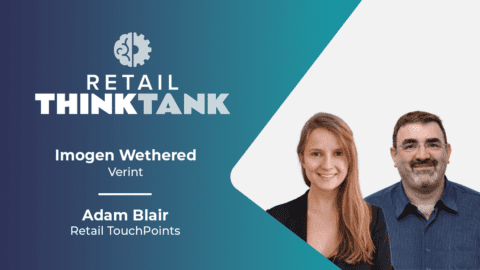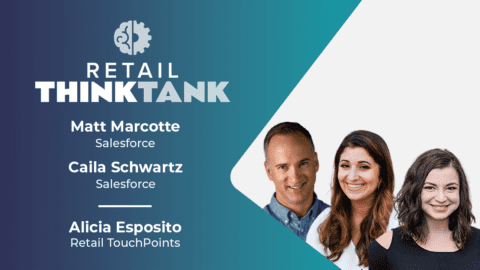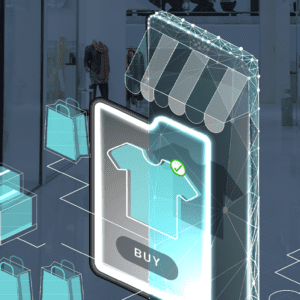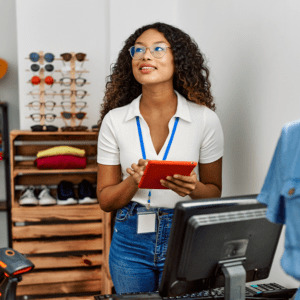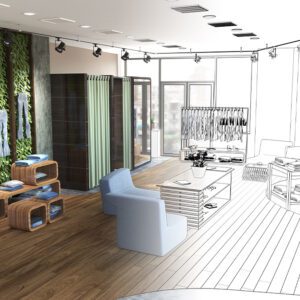It might sound strange to say this about a place where some 80% of transactions actually take place, but brick-and-mortar stores represent an underutilized resource, according to Sarah Jarvis, co-author of the second edition of Omnichannel Retail: How to Build Winning Stores in a Digital World.

Jarvis and Tim Mason, CEO of Eagle Eye and author of the book’s first edition, contend that there are many more opportunities to personalize and add value to the in-store shopper journey than retailers are currently using. Many involve making all in-store customer touch points, including scan-and-go devices and shoppers’ own phones, more targeted to shoppers’ needs in the moment.
Jarvis, who serves as Communications and Propositions Director at Eagle Eye, also shared her insights on how retailers can shape loyalty programs to meet their particular business needs, both by eliminating pain points and adding tangible value to the shopper journey.
Retail TouchPoints (RTP): What are some of the biggest updates to this second edition of the book?
Advertisement
Sarah Jarvis: The whole thing was basically rewritten, so it’s a pretty significant update, mainly because, with the impact of COVID, things changed way faster than Tim had predicted in the first edition. The cost-of-living crisis and inflation has had a massive impact that has meant things like a [major shift to] member pricing, which I know has been a big thing in the U.S. for a lot longer than it has in the UK.
Then I put in new chapters that touch on things like the foundations of loyalty. There’s one specifically just about personalization; we talk about how you can monetize customer data, mainly through relationships with CPGs; and retail media, which are all part of the same thing. And then the final chapter we added, which is a topic that is close to both Tim’s and my heart, is all about culture, which is really about the power to do things in the right way rather than the wrong way.
RTP: You talk in the book about the idea of a “digital imperative.” Can you tell me more about what you mean by that, and what the implications are for retailers today?
Jarvis: Tim’s got this big concept about stores being a digital “black hole.” We all, through the medium of our phones, are used to everything being personalized to us. You turn on your TV, everything’s personalized for you; you go into Spotify, you don’t see artists that you’ve never heard of apart from in “Discover Weekly,” and then it’s all curated to be things that you like. So we’ve built this world of expectation for consumers where they’re like, “Oh, everything that I see through this medium is all about me.” And then they walk into a physical store and there’s no WiFi, there’s no connection, there’s nothing very personal, and there are like 70,000 red stickers all over the store giving you promotions on things that you kind of just glaze over because it’s too much.
The digital imperative is that you can’t get away with that anymore. You have to find meaningful connections with your customers, and digital’s the way you’re going to do it. And I think that’s only accelerated, particularly with things like the cost-of-living crisis, and how you can try and use personalization to give customers value when they’re desperate for value.
For example, the member pricing has gone completely mad in the UK, everyone’s doing it, but it’s still very mass-marketing-oriented. I walked into my local Sainsbury’s the other day, and I’ve got a 2 year old, and the whole front of the store was taken up by Pampers nappies [diapers] with for-member pricing. For me this was like, “Oh my God, this is brilliant,” but for probably 85% of customers walking into the store, all of that space is just being given to a mass promotion on a product that is totally irrelevant to them.
Physical stores still need to be interesting and engaging, but [the question becomes] how do you actually use the digital connection to put the right products and the right offers in front of customers, so that you’re giving that sense of great value to everyone rather than just to the 15% of people who have got, unfortunately, children in nappies?
RTP: What role(s) do you see for shoppers’ mobile phones in stores?
Jarvis: Increasingly, shopping is becoming a phone-out activity rather than a phone-in-the-pocket activity. And as with anything, if you want customers to do more of it, you’ve got to make it worth their while — so what value can you deliver whilst that’s happening?
We were speaking to a retailer maybe a year ago and shared the idea that shopping is going to be “phone-out” and he was like, “Absolutely not.” And we asked, “Do you watch TV with your phone?” And he said “yeah.” Is watching TV with your phone that much stranger of a concept than walking around a store with your phone? People do it; it’s gonna happen.
Additionally, we talk about this concept of a “digital mosaic of attraction.” No one thing is going to work for everyone, but I always use scan-and-shop on my phone now because I normally have a pram and I don’t want to hold a basket. However, the scan-and-shop is totally unrelated to anything I’ve ever bought. It doesn’t do any real-time messaging to me; it doesn’t tell me I’ve missed out on two offers. I think where it will go is that all of the brilliant things that happen when you’re shopping online will start happening as you walk around the store. This will be further into the future, because no one wants to spend money on it, but [think of] real-time tracking of where customers are in-store — basic stuff you could do now. It doesn’t now, but it could provide me recipes as I’m shopping, or ask “Do you want something to go with the chicken?”
That’s not going to appeal to everyone, but that will get you some customers. For others it will be about faster payment; for other people it will be about just-walk-out. There are lots of things that have got to happen, but it’s about building in value. For some people that’s speed; for other people it’s price; for other people it’s information.
For example, we do a lot of work with Asda in the UK, and they just launched a campaign for their first-ever loyalty program a year ago. As part of the [loyalty program’s] first birthday celebration, they launched a thing in the app called Spin to Win — you spend £5 and you get a free spin to win things like cash prizes. We launched it and on day one we could see the volumes coming through on our platform. It was unbelievable; people were obsessed. People were taking baskets of like £100, taking five items, spending £5, getting the spin, then going back to the back of the queue to get another spin.
RTP: I wanted to ask you about this McKinsey idea of the “zero customer,” which is basically that there’s zero loyalty and there’s almost nothing that brands can do to change that. Do you agree with this idea that there is essentially no such thing anymore as consumer loyalty? And if so, what can retailers do about it?
Jarvis: The data we see is that loyalty programs have had a massive uptake in the last year or two. because consumers see it as a way to get value from the retailer. And I think if [retailers] do it well, then the way you personalize helps keep them coming back. But they’re loyal probably in a more transactional way rather than loyal with deep emotion: “I’m a member of this program; I swipe my card every time because it makes my basket cheaper today.”
Whereas loyalty 20 years ago was all about currency for tomorrow and the concept of saving, and then you spend that in one splurge so that your champagne on Christmas Day was paid for by your loyalty. That has definitely shifted. There’s still a big element of that, but I think this idea of needing to give value today linked to your loyalty proposition is definitely true. But then [the question becomes] how do you engender long-term loyalty? It has to be through personalization and just making [the shopping experience] easier.
[I read somewhere that] retailers used to talk about growing share of wallet but now they need to get a share of life, and we see that quite a lot. Loblaws in Canada, which we do a lot of work with, does a lot of interesting stuff. For example, they started rewarding customers for purchases outside of their stores through their marketplace. They reward customers who do 10,000 steps a day because they’ve linked their loyalty card to the Apple Watch. Loblaws doesn’t really care if a customer does 10,000 steps or not, because it doesn’t impact their bottom line, but it makes the consumer more engaged in the [loyalty] scheme, gives them more ways to earn points, keeps them in that engagement and makes it about more than just about spending money. It’s more than just: “Come here and buy stuff.” It’s like, “Let me help you live a better life.”
RTP: We’re talking about things that we tend to think of as digital, but you are showing a lot of it is actually happening now in the physical retail environment. How do you see the role of the store evolving in these omnichannel environments?
Jarvis: Globally something like 79% of retail sales still happen in stores, and the ability to give customers convenience is easier in a real store; from an immediacy point of view, you can get the product now. Additionally, I think there’s a big trust angle from a physical store versus a generic marketplace. For example, Amazon says they’re the most customer-centric company in the world, but [even when you] search for a specific product that you want, the exact thing, you have to scroll through a list of 20 other products before you get to the one you want. That concept gets taken away in the physical store — that is, if you can nail this mobile connection where you’re giving that personalized experience that [you typically] get with ecommerce.
We talk about this concept of how the phone should be a companion to help you navigate the physical world. For example, in Nike stores you can scan a QR code to get someone to bring you a pair of shoes in your size, which is historically a really irritating thing when you’re trying to buy shoes.
I think a lot of it is just trying to figure out what the pain points are. And again, it doesn’t have to be for everyone, but there are lots of things that you can solve for. What’s the “Uberization” of your physical store? How do you get people stuff quicker? How do you navigate them to the right place faster? How do you give them value more easily?
RTP: It’s funny you mentioned Amazon because one of the things I wanted to talk about was this example in the book of the missed opportunity of Amazon-Whole Foods. What do you think is going on there? Because it’s very unlike Amazon as a company.
Jarvis: A lot of people think that Amazon underestimated how difficult it is to run a physical store network. They’re brilliant at ecommerce, but suddenly you’ve got this whole different beast of real stores. I think Whole Foods has kept a lot of what made them great, which is amazing range and other differentiators.
On the other hand, Amazon Go was a great idea, but the stores were really sterile and not very exciting. They were just clinical grocery stores that did what they said on the tin. Yes, you could just walk out, which was novel, but they didn’t have any of the magic that [other] grocery stores have.
Amazon is new to the game, and I’m sure they’ll learn quickly, but the Amazon-Whole Foods [relationship] is weird. Everyone was quite panicked [when Amazon bought it], thinking that if they could link the customer together and know everything I’ve ever bought on Amazon and everything I’m buying at Whole Foods, the cross-sell opportunity would be massive. Amazon could do personalized content to those customers, but they don’t really, and the Prime benefits that you get from Whole Foods aren’t particularly compelling, so it’s strange.
RTP: That seems to present an opportunity to other retailers, the ones with roots in brick-and-mortar that know about creating a magical store experience. Amazon’s left an opening for them, but you also say in the book that other retailers are “stuck in the headlights of the Amazon truck.” Tell us how they can unfreeze and take advantage of this opportunity.
Jarvis: The businesses that do cool stuff that is working seem to be those that figure out something that really resonates for their brand and their customers. We talk quite a lot about Target in the book. We don’t work with them, but they didn’t try and copy what Amazon was doing. They didn’t try to make a subscription like Prime and bundle a load of stuff in, which is brilliant for Prime. But instead of copying that, Target has made it about coming to the store — experience our products or drive up and get stuff put in your car without you having to get out. They’ve built their own proposition that works for them.
We do a lot of work with Woolworths in Australia, a market-leading grocer. They built a subscription product that I think everyone thought would be their version of Prime, but it’s also about coming into the store. Members get a gift [at regular intervals], something that is a locally produced product that that store wants to give you. So you might get some olives or some wine that’s made at the local vineyard. It’s about getting customers to come in and experience the store rather than saying, “Oh, we’ll deliver it to you free on the same day or next day.”
RTP: If you had to, how would you summarize the book in one sentence?
Jarvis: Everyone talks about this stuff like it’s so difficult, and bits of it are difficult, but just crack on and do something and you will get quite a lot of the way there. For example, everyone’s talking about one-to-one [personalization], but perhaps you can only do segmented marketing. So then do segments really well and build it out from there, and just relentlessly pursue it. If you decide that you want everyone to walk around your store with their phone out, then have a table at the front of every store with a really friendly person that’s going to help people download the app.




